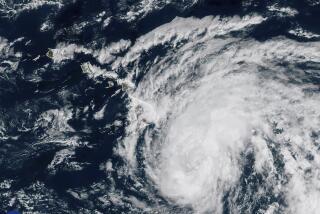Canoe to Set Sail to Remote Island
- Share via
HONOLULU, Hawaii — A Hawaiian seagoing canoe that has already sailed 100,000 miles to prove that ancient Polynesians navigated by the stars, is set for its greatest challenge yet--a trip to the world’s most remote inhabited island.
The five-month, 7,500-mile voyage is from Hawaii to Easter Island, 2,200 miles west of Chile and famous for its monolithic stone heads. The trip is expected to begin as soon as weather permits.
Just finding the island will be a supreme test for the 12-person crew, led by master navigator Nainoa Thompson.
The Hokule’a, a fiberglass and wood replica of sailing canoes used 2,000 years ago, was in Hilo Bay on the island of Hawaii on Friday, awaiting favorable winds for the first leg of the voyage, southeast to Nuku Hiva in the Marquesas Islands.
From there, it will set sail in August for Mangareva in the Gambier Islands. Mangareva is the launch point for the third, and most difficult leg to Easter Island, known to its inhabitants as Rapa Nui.
The crew of the double-hulled voyaging canoe Hokule’a has set a limit of only 40 days to make the daunting 1,450-mile trip from Mangareva to Easter Island.
Easter Island is smaller than any previous destination the canoe has sailed to--only 16 miles from end to end--and will require the crew to sail the final leg of the trip into the wind.
The crew will navigate using only the stars. The canoe has no navigational aids and no radio, although it will be tracked by a motor-equipped sailboat.
The crew will have to sail within 46 miles of Easter Island in clear weather during daylight to find it. Unlike other islands, Easter Island does not have a land-based population of seabirds that navigators can sometimes use to direct them to islands from as far as 150 miles out to sea.
“The crew is saying this is going to be the most difficult sail they’ve ever done,” said Myron “Pinky” Thompson, president of the Polynesian Voyaging Society and Nainoa’s father. The society owns the canoe.
“The island they are trying to find without instruments is a speck of land,” he said.
To give the voyagers a sense of urgency and to reduce weight, food and water rations have been cut in half for the last leg.
The Hokule’a has been a potent symbol for Hawaiians since the mid-1970s, when its crews proved that ancient Hawaiians could use the stars to navigate the Pacific. Its journeys to Tahiti, New Zealand and the Marquesas revived the ancient art of star navigation.
Hokule’a means “Star of Gladness” in Hawaiian. It proved that Polynesians were capable of purposely settling the Pacific. In 1973, artist and historian Herb Kane dreamed of the canoe as a way to challenge theories by Norwegian explorer and anthropologist Thor Heyerdahl, who believed that Polynesians drifted aimlessly across the ocean from South America.
In 1974, Heyerdahl made his famous “Kon Tiki” voyage, drifting on a raft from Peru to the Polynesian island of Tuamotu to prove his theory.
The voyages of the Hokule’a have challenged Heyerdahl’s theory and shown that ancient Polynesians could have navigated by the stars and inhabit the islands intentionally.
This trip will complete 25 years of voyaging and is being viewed as the final leg of “the Polynesian triangle.” Since it first sailed, the Hokule’a has visited every major island or island group in Polynesia except Easter Island.
The Polynesian Voyaging Society is stressing safety, which is why it has put a 40-day limit on the final leg of the trip. An escort boat, the 40-foot motorized sailboat Kamahele, will be nearby in case of an emergency, but it will not be in contact with the Hokule’a.
Even if the canoe should fail to find Easter Island on its own, its every move will be recorded for study. A transponder aboard will record its position via satellite links to Hawaii.
More to Read
Sign up for The Wild
We’ll help you find the best places to hike, bike and run, as well as the perfect silent spots for meditation and yoga.
You may occasionally receive promotional content from the Los Angeles Times.






